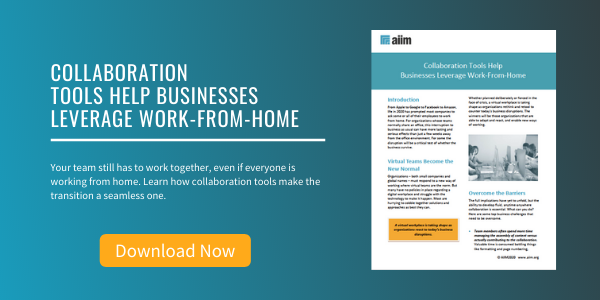
The #AIIM15 Digital Transformation Hot Seat: Security in a World of Anywhere, Anytime Access
Collaboration | Intelligent Information Management (IIM) | Digital Transformation
As we start to think about #AIIM15, I thought I would ask a number of our sponsors a few identical questions in order to get an understanding of how they see the future of our industry -- and let those of you attending start to think about your own questions to ask them in San Diego. Here are the three questions I'll ask:
- What are the three biggest challenges you see your customers facing while trying to “Embrace the Chaos”?
- What do you see as the three most important trends related to Information Management facing organizations over the next 18-24 months? What will be different in our industry two years from now?
- What are the three most important things attendees should know about your company?

Mike Maxey, Director of Content Solutions at AirWatch by VMware, says high-profile data breaches have brought security to the forefront of the anywhere, anytime access conversation.

What are the three biggest challenges you see your customers facing while trying to “Embrace the Chaos”?
Access, Enablement, and Control.
The reality people want to work anywhere, anytime, as life allows, and end-users now dictate which tools they are going to use to manage their business life. With the explosion of mobile, dozens of tools have been created for workers to access productivity tools on multiple devices, with the functionality they need and usability that is simple. Unfortunately for IT leaders, this paradigm has opened many issues with tough planning dynamics. The possibility of data breaches and sensitive data leakage has grown exponentially, with many consumer-grade tools being used in the enterprise. Without an enterprise-grade alternative with end user-centric features, IT leadership is often forced to be the “bad guy,” blocking services to access files, videos, or social networks that are becoming critical to workers who use these services to manage their personal and business lives. Organizations need a partner who can help bring these tools to business while satisfying security concerns in a world where we see almost monthly high-profile data breaches.
What do you see as the three most important trends related to Information Management facing organizations over the next 18-24 months? What will be different in our industry two years from now?
First, with more and more high profile data breaches, organizations are adding up the costs of their peers and realizing just how much is at risk in an unencrypted, poorly controlled, and non-managed information sharing environment. Second, as more workers become familiar with collaboration tools, work between multiple affiliated organizations around the globe will need to be facilitated with enterprise-grade tools. Lastly, this is being driven by the adoption of tools in business that younger generations have been using to manage their personal lives for several years. These workers continue to take on broader roles in organizations, including leadership positions, and the work-style they are implementing requires flexibility in information management policies and access privileges that work for the user, not against them.
Two years from now, I see automation becoming much more widespread, intelligent workflow expanding across multiple systems and organizations being tied into these processes. What will really change the game is when machine learning experts begin integrating some of those technologies into workflows and the process improves itself over multiple cycles, learning from the data gathered in real-time and historically.
What are the three most important things attendees should know about your company?
Leaders need a partner for technology solutions that empower them to be flexible to meet their employee’s needs. Knowledge workers are very adept at identifying tools, applications, and processes to do their jobs most effectively. Often, this means IT managers are forced to support and manage multiple systems and solutions, which creates silos and complexity. AirWatch Content Locker and the entire AirWatch productivity suite takes an open integration approach that solves this friction and brings everyone together regardless of storage strategy to collaborate, communicate and share on a single secure platform that solves IT concerns and gives workers freedom. In summary, our company gives three important things: IT piece of mind, user freedom, and application openness.
About John Mancini
John Mancini is the President of Content Results, LLC and the Past President of AIIM. He is a well-known author, speaker, and advisor on information management, digital transformation and intelligent automation. John is a frequent keynote speaker and author of more than 30 eBooks on a variety of topics. He can be found on Twitter, LinkedIn and Facebook as jmancini77. Recent keynote topics include: The Stairway to Digital Transformation Navigating Disruptive Waters — 4 Things You Need to Know to Build Your Digital Transformation Strategy Getting Ahead of the Digital Transformation Curve Viewing Information Management Through a New Lens Digital Disruption: 6 Strategies to Avoid Being “Blockbustered” Specialties: Keynote speaker and writer on AI, RPA, intelligent Information Management, Intelligent Automation and Digital Transformation. Consensus-building with Boards to create strategic focus, action, and accountability. Extensive public speaking and public relations work Conversant and experienced in major technology issues and trends. Expert on inbound and content marketing, particularly in an association environment and on the Hubspot platform. John is a Phi Beta Kappa graduate of the College of William and Mary, and holds an M.A. in Public Policy from the Woodrow Wilson School at Princeton University.


